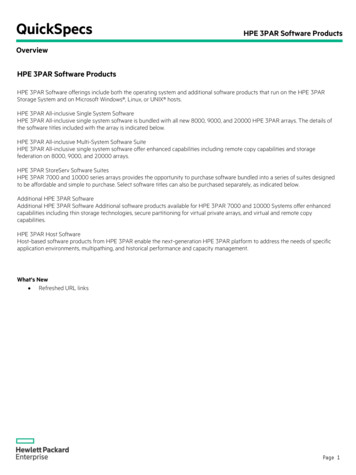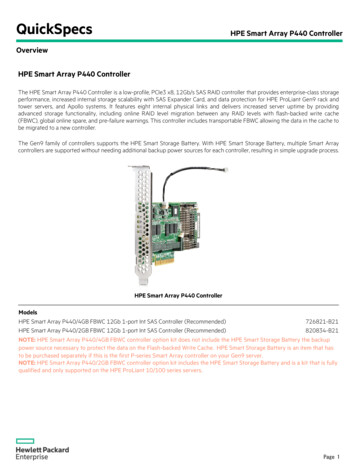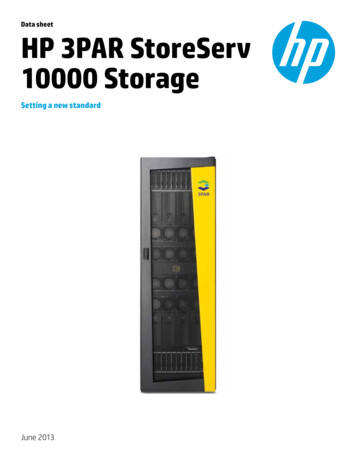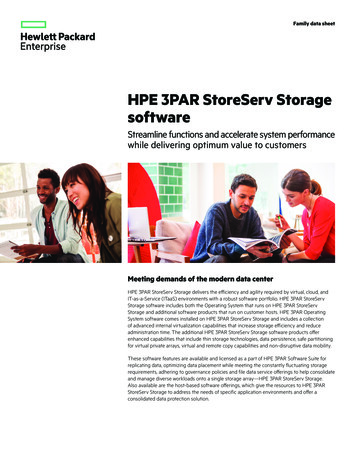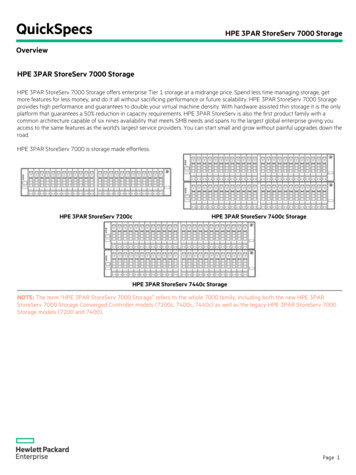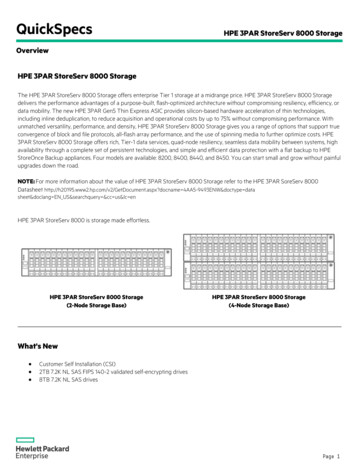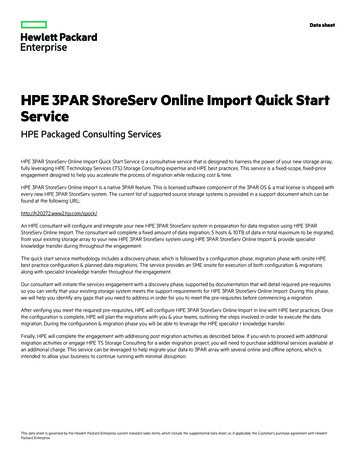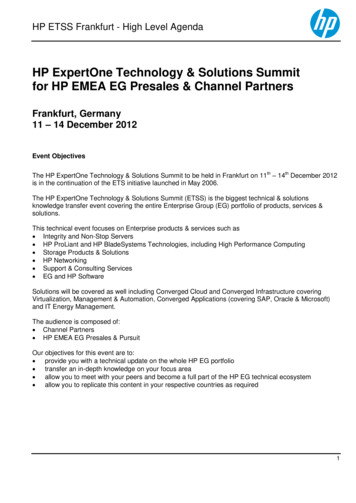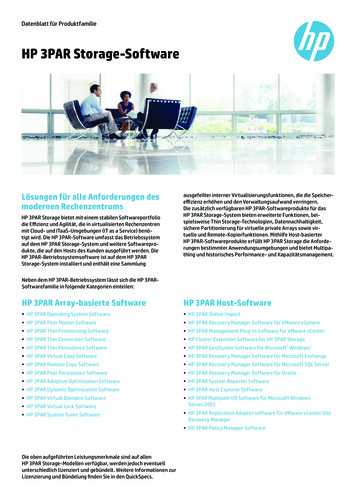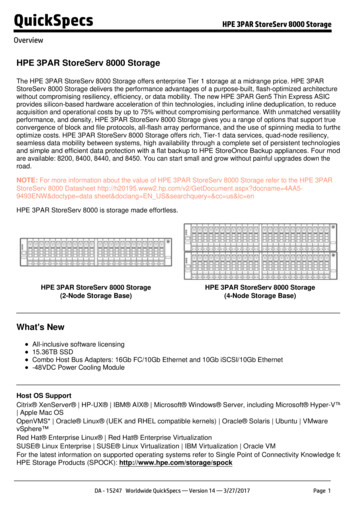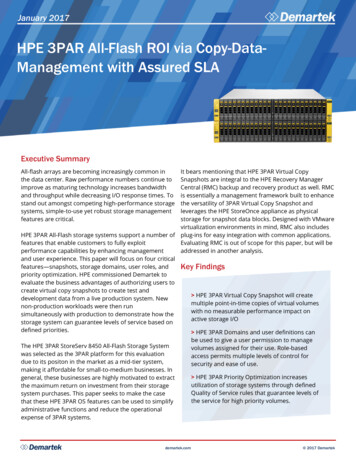
Transcription
January 2017HPE 3PAR All-Flash ROI via Copy-DataManagement with Assured SLAExecutive SummaryAll-flash arrays are becoming increasingly common inthe data center. Raw performance numbers continue toimprove as maturing technology increases bandwidthand throughput while decreasing I/O response times. Tostand out amongst competing high-performance storagesystems, simple-to-use yet robust storage managementfeatures are critical.It bears mentioning that HPE 3PAR Virtual CopySnapshots are integral to the HPE Recovery ManagerCentral (RMC) backup and recovery product as well. RMCis essentially a management framework built to enhancethe versatility of 3PAR Virtual Copy Snapshot andleverages the HPE StoreOnce appliance as physicalstorage for snapshot data blocks. Designed with VMwarevirtualization environments in mind, RMC also includesHPE 3PAR All-Flash storage systems support a number of plug-ins for easy integration with common applications.features that enable customers to fully exploitEvaluating RMC is out of scope for this paper, but will beperformance capabilities by enhancing managementaddressed in another analysis.and user experience. This paper will focus on four criticalfeatures—snapshots, storage domains, user roles, andKey Findingspriority optimization. HPE commissioned Demartek toevaluate the business advantages of authorizing users tocreate virtual copy snapshots to create test and HPE 3PAR Virtual Copy Snapshot will createdevelopment data from a live production system. Newmultiple point-in-time copies of virtual volumesnon-production workloads were then runwith no measurable performance impact onsimultaneously with production to demonstrate how theactive storage I/Ostorage system can guarantee levels of service based ondefined priorities. HPE 3PAR Domains and user definitions canThe HPE 3PAR StoreServ 8450 All-Flash Storage Systemwas selected as the 3PAR platform for this evaluationdue to its positon in the market as a mid-tier system,making it affordable for small-to-medium businesses. Ingeneral, these businesses are highly motivated to extractthe maximum return on investment from their storagesystem purchases. This paper seeks to make the casethat these HPE 3PAR OS features can be used to simplifyadministrative functions and reduce the operationalexpense of 3PAR systems.demartek.combe used to give a user permission to managevolumes assigned for their use. Role-basedaccess permits multiple levels of control forsecurity and ease of use. HPE 3PAR Priority Optimization increasesutilization of storage systems through definedQuality of Service rules that guarantee levels ofthe service for high priority volumes. 2017 Demartek
HPE 3PAR Storage Domains, User Roles,Virtual Copy Snapshots, and PriorityOptimizationImproving Storage System ROI withDelegated Management, Volume Snapshot,and Priority OptimizationCurrent generation, enterprise-class all-flash storagesystems deliver gigabytes of bandwidth and millions ofIOPS at sub-millisecond response times. Features thatimprove data management, enhance usability, andsimplify administration may be perceived to be ofsecondary importance compared with these rawperformance metrics. However, this is a short-sightedview and may be costly in the long run if it drivespurchasing decisions.HPE 3PAR All-Flash Storage Systems, like the 3PARStoreServ 8450 highlighted in this report, leverage the3PAR OS to deliver high performance flash plus a wealthof other features. Many of these OS features aredesigned to capitalize on the benefits of flash tosignificantly expand the role a 3PAR storage system canplay in the data center. It would take severalwhitepapers to describe all of the extras HPE haspacked into the 3PAR OS. Instead, this paper will focuson four advantages the HPE 3PAR 8450 can bring to ause case that is fairly common to many businesses,specifically replicating production data for developmentand testing.Most businesses that develop in-house software foroperations, or purchase enterprise software, willmaintain active development and test environments toprotect production from errors and outages. It is acommon practice to populate these developmentenvironments with production data. Copying andstaging this data consumes human and computeresources, both of which have a cost, particularly ifdevelopment/test environments are isolated to nonproduction hardware (historically a best practice toavoid resource stealing and outages on productionsystems). HPE 3PAR storage systems and the 3PAR OSinclude technology specifically designed to minimizethese expenses. The following is a brief summary of thefeatures leveraged to validate how the HPE 3PAR OSand the StoreServ 8450 All-Flash storage system makethis use case more efficient in terms of effort and cost.demartek.comDomains and UsersThe 3PAR storage administrator has the ability to definestorage domains, which can be thought of as logicalgroupings of resources on the HPE 3PAR storagesystem. Once defined, users added to the storagesystem can be assigned to a specific domain andgranted privileges ranging from view-only to fulladministration of the volumes within that domain.Figure 1 – Defined users and domainsIn Figure 1, the user sqldba is assigned an ‘edit’ role tothe SQLServer domain. This configuration permits thestorage administrator to offload many of themanagement functions for this domain to the sqldbauser. The ‘edit’ role is pretty liberal in the number ofprivileges it grants, so the storage admin needs to havea high degree of confidence in the human being grantedaccess to this 3PAR user. The payoff is in time saved bythe administrator through offloading storagemanagement tasks needed by the applications usingvolumes on the SQLServer domain.Virtual Copy SnapshotsA snapshot is an exact image of a volume or set ofvolumes. Some implementations of snapshottechnology create complete physical copies of theoriginal volumes. The HPE 3PAR OS creates much morespace-efficient snapshots through metadata copies ofthe original image. This involves making pointers to theoriginal data blocks rather than duplicating thoseblocks. When snapshots are read, the pointers direct 2017 Demartek
HPE 3PAR Storage Domains, User Roles,Virtual Copy Snapshots, and PriorityOptimizationthe read process to the appropriate blocks in the“parent” volumes. When data is written to an originalvolume, any data referenced by a snapshot is preservedand the updates are written elsewhere whileappropriate metadata changes are made. For all intentsand purposes, the snapshots require no space on-driveuntil updates occur to the parent volumes.Read-only snapshots may be taken as point-in-timebackups. The HPE 3PAR OS also supports read-writesnapshots which, as the name implies, can be updatedany time after they are created. As with read-onlysnapshots, space requirements for read-writesnapshots start out very small, with actual data blocksonly written as the snapshot is edited.Since the process of creating a snapshot is a metadataoperation, it is performed instantaneously andconsumes very little processing power. This allowssnapshots to be taken against live production data withlittle to no performance impact on the volumes. As atrue point-in-time image, snapshots of live volumes canbe used to restore those volumes or applied to otherapplication environments without risk of datacorruption.Priority OptimizationOne of the reasons to separate production data fromnon-production is to prevent development and test jobsfrom consuming the storage resources that are neededto meet production service level agreements. This istypically done by deploying separate environments.However, all-flash systems may deliver enoughperformance to accommodate these functions on thesame storage system, potentially saving money byreducing device counts in the data center.Unfortunately, even with all-flash systems, the risk ofimpacting production doesn’t completely go away.Production needs may grow over time, or resourceconsumption of non-production loads may spike forsome reason or other. Fortunately, the HPE 3PAR OShas a way to mitigate this risk. Priority Optimizationallows storage administrators or users with sufficientrole-granted privileges to assign performancethresholds on 3PAR volume sets. Volumes can belimited to certain ranges of bandwidth, IOPS, orassigned minimum latency goals. Individual prioritiesallow the operating system to throttle the performanceof low priority volumes (development for instance) ifhigh priority volumes are in danger of not meetingdefined performance requirements.Figure 2 – A parent volume with multiple snapshots.Figure 2 represents a use case in which multiplesnapshots are created against a single databasevolume. Read-write snapshots, which will change overtime, can be assigned to development and testdatabases, while a read-only snapshot may be retainedas a backup, or a “golden image” from which to createadditional snapshots.demartek.comFigure 3 demonstrates priority optimization settingsapplied to two virtual volumes and three snapshots thatare exported to development systems as database datavolumes. The production OLTP volume is configuredwith a response time goal of .5 milliseconds andassigned a “high” priority. A data warehouse volume isgiven a bandwidth range and the 2017 Demartek
HPE 3PAR Storage Domains, User Roles,Virtual Copy Snapshots, and PriorityOptimizationdevelopment OLTP snapshots are assigned IOPS rangesto operate within. Data warehousing and thedevelopment snapshots are assigned a “low” priority.Figure 4 – Use case test configurationFigure 3 – Priority Optimization values assigned to different volumes onthe storage systemThe HPE 3PAR OS will balance the performance of allvolumes to try to keep each one within the definedranges. If the production OLTP volume, with its highpriority, begins to exceed its response time target, theOS will throttle performance of the lower priorityvolumes to guarantee service to production OLTP.The Use Case ValidationThe test case evaluated by this project is the same onedescribed in the preceding section. We configured anHPE StoreServ 3PAR 8450 All-Flash storage system(Figure 4) with a domain for our hypothetical databaseteam to manage. A separate Windows server wasdeployed to support each Microsoft SQL Serverapplication instance, receiving storage resources fromthe 3PAR 8450 over Gen 5 Fibre Channel. As this was astorage system validation and not a server performancetest, we reduced the server memory available to SQLServer to a mere 8GB to minimize data caching andforce storage I/O.demartek.comTwo validation tests were executed in turn. First, theproduction OLTP application was started. After itachieved a steady-state of operation, a series of sixsnapshots were taken while we examined theperformance metrics for any noticeable impact. Thesecond scenario involved assigning three of the readwrite snapshots as data volumes for developmentdatabases and deploying a data warehouse applicationin addition to the production OLTP workload.Thresholds, latency goals, and priorities were set asshown in Figure 3. Beginning with the production OLTPworkload, followed by data warehousing, and finally thedevelopment/test databases, each application wasstarted in turn at roughly fifteen minutes intervals.Performance was recorded and evaluated with priorityoptimization definitions initially disabled, then enabledand the workload repeated for comparison. Metricswere gathered through Windows Perfmon, at theapplication servers, and directly on the 3PAR StoreServ8450 by way of HPE 3PAR System Reporter. 2017 Demartek
HPE 3PAR Storage Domains, User Roles,Virtual Copy Snapshots, and PriorityOptimizationResults and AnalysisAdministration Delegation and Virtual CopySnapshotsThe user and domain configuration worked as defined.We were able to log on to the HPE 3PAR StoreServ 8450and manage all resources within the SQLServer domain,including creating volumes and volume sets, takingsnapshots, and assigning priority optimization settings.As the sqldba user, we could neither see nor interactwith any other resources on the 3PAR system. The ‘edit’role does offer a great deal of autonomy to the user.This has the benefit of allowing the storageadministrator to set up the domain and basically walkaway from it. However, if the application team does notpossess the appropriate knowledge and/or experienceto safely manage the storage resources, more restrictiveroles are available.After creating volumes for the production OLTPdatabase and the data warehouse, the OLTP databaseapplication was started and tuned until the processesconsumed roughly 65% of the server processingcapacity. This produced about 9000 databasetransactions per second. I/O response times were justunder .4 milliseconds, and storage bandwidth wassteady at around 1270 megabytes per second.Operating under the assumption that any performancedegradation on the storage system would be magnifiedat the server, all three metrics were gathered byWindows Perfmon at the database host.After about thirteen minutes of steady state operation,six virtual copy snapshots were taken. As Figure 5demonstrates, no noticeable performance impact wasrecorded in any of these metrics.Figure 5 – Several metrics demonstrating no impact to storage orapplication performance when taking multiple Virtual Copy Snapshotsdemartek.com 2017 Demartek
HPE 3PAR Storage Domains, User Roles,Virtual Copy Snapshots, and PriorityOptimizationWe indicated earlier that HPE 3PAR snapshots were veryspace efficient, given that no data blocks are affecteduntil updates occur to the parent volume or to a readwrite snapshot. For this reason, the operating systemwill support thousands of snapshots. As Figure 6 shows,six snapshots of the 1.5TB production volume consumeonly 342GB of on-drive space, which were the datablocks written to by the development workloads aftermany hours of execution and those blocks in the parentvolume that had to be written out due to updates afterthe snapshots were taken.Priority OptimizationTaking advantage of three of the read-write snapshotscreated in the prior test phase, we provisioned threedevelopment servers and exported those snapshots tothem as data volumes (it is worth noting that thesnapshotted data volumes were attached without issueto the development database instances). The value ofpriority optimization is supposed to be the ability toconsolidate multiple workloads of differing importanceon the same HPE 3PAR storage system, without risk tothe service levels of the most critical. In this section, wewill examine that claim by evaluating the performanceof each workload against its defined priorityoptimization settings.With production OLTP considered the highest priorityapplication in the test environment, we will consider thebehavior of its volumes first. Our hypothetical servicelevel requirements declare latency to be the criticalmeasure of acceptable performance. Figure 7 contraststhe average response times of production OLTP I/O withpriority optimization first disabled then enabled.Figure 7 – Highest average latency of production OLTP workload volumesIt is clear that with priority optimization turned off, thestorage system is not keeping latency within .5milliseconds. This is most evident starting around 1800seconds into the workload, when the development/testdatabase applications were started. This is contrastedwith a steady .2 to .25 millisecond response time whenthe priority optimization engine is enabled.Data warehousing was assigned a low priority, but asanother production job, we’ll examine it next. ThisFigure 6 – Snapshot space efficiencydemartek.com 2017 Demartek
HPE 3PAR Storage Domains, User Roles,Virtual Copy Snapshots, and PriorityOptimizationworkload is not latency sensitive, nor does it generate alot of IOPS, but it is bandwidth intensive. In Figure 8, wecan see the volume bandwidth dipped below theminimum bandwidth threshold of 500 megabytes persecond several times when priority optimization wasdisabled. This happened only once after we turnedpriority optimization on and was corrected very quickly.After the development workloads were executed (at1800 seconds), the highly variable nature of thebandwidth suggests that the priority optimizationengine was making adjustments to volume performanceto support response time demands of production OLTP.Figure 9 – IOPS of dev/test database volumesThe performance profile of this test case seems to bearout the claim that HPE 3PAR priority optimization canprovide a performance guarantee to critical applicationsin a multi-workload environment. This type of feature isa logical addition to a high-performance all-flash storagesystem like the HPE 3PAR StoreServ 8450 and should bea definite value-add to enterprises interested inconsolidating applications onto fewer, more powerfulstorage systems.Summary and ConclusionFigure 8 – Data warehouse bandwidthThe final workload in this use case was composed of thethree development databases created from theproduction snapshots. These low priority workloadswere given a fairly narrow IOPS range to operate in (orrather a narrow range for an all-flash system). Here wesee the most obvious re-balancing of I/O to guaranteethe latency target of the highest priority rule—production OLTP. The databases appear to be capableof a little over 100,000 IOPS in this mixed workloadenvironment. The priority optimization engine actuallyreduced that I/O by 10,000 IOPS over the baseline(Figure 9). Comparing time stamps when this occurredto the production OLTP latency charts in Figure 7, wecan see that this adjustment lines up nicely with whenresponse times would have increased were priorityoptimization disabled. From this we conclude that thedevelopment I/O was corrected by the operating systemto keep production latency low.demartek.comBandwidth, IOPS, and response times should not be theonly factors under consideration for high-end storageinvestments. These storage systems are multi-functioncomputers in their own right and can deliver a bevy offeatures to simplify and streamline storagemanagement across the datacenter. Additionally,current generation all-flash systems have performancecapacity to spare in all but the most extreme use cases.This extra capacity can be harnessed to support morework than ever before. Storage management notionsheld over from the era of slow magnetic media may beholding back the full value of flash storage in the datacenter by limiting the complete deployment of usablestorage.Features to ease and reduce storage administrationtasks make the entire enterprise more efficient.Application owners are able to take control of their ownresources on their own schedule, without placing otherassets at risk, and the storage administrator no longerneeds to respond to basic maintenance andmanagement requests from those teams. Technologythat facilitates greater utilization of a storage system 2017 Demartek
HPE 3PAR Storage Domains, User Roles,Virtual Copy Snapshots, and PriorityOptimizationreclaims underutilized capacity for a greater return oninvestment and potentially empowers the enterprise toconsolidate functions onto fewer, or individual, devicesfor significant cost savings in hardware andadministration.HPE provides all these opportunities in the HPE 3PARStoreServ product line. The HPE 3PAR OS is purposebuilt to enable storage teams to compartmentalizestorage resources for delegated management and tocapitalize on the power that flash systems bring to thedata center. Guaranteed performance levels, throughpriority optimization, challenge traditionalimplementation strategies by offering low riskconsolidation of disparate workloads. Storagearchitects, administrators, and data center managersare advised to consider the value-add of features suchas those highlighted in this report when consideringfuture storage system investments or strategies to getmore out of already deployed HPE 3PAR StoreServ 8000series systems. To do otherwise risks leaving valuablecost saving opportunities and system performance onthe table.The most current version of this report is available athttp://www.demartek.com/Demartek HPE 3PAR Snapshots 2017-01.html on the Demartek website.HPE, 3PAR, and HPE 3PAR StoreServer 8450 are among the trademarks of HPE Corporation and/or its affiliates in theUnited States, certain other countries and/or the EU.Microsoft, Microsoft Windows, and Microsoft SQL Server are registered trademark of Microsoft, Inc.Demartek is a registered trademark of Demartek, LLC.All other trademarks are the property of their respective owners.HPE document number a00000486enwdemartek.com 2017 Demartek
HPE 3PAR All-Flash Storage Systems, like the 3PAR StoreServ 8450 highlighted in this report, leverage the 3PAR OS to deliver high performance flash plus a wealth of other features. Many of these OS features are designed to capitalize on the benefits of flash to significantly expand the role a 3PAR storage system can play in the data center. It .
